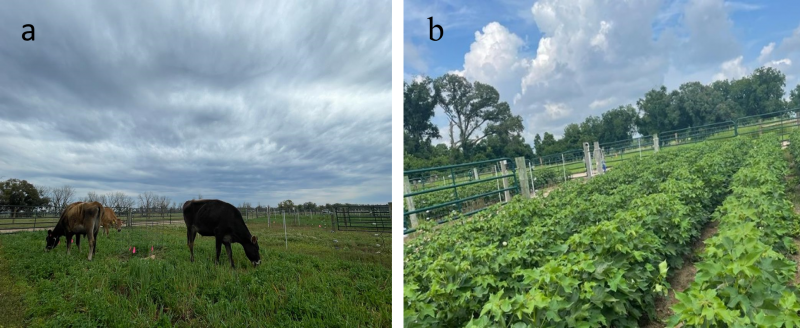A new University of Florida project aims to “play matchmaker” between ranchers with livestock and landowners with grazing space. The Southeast Grazing Exchange, funded by the Florida Department of Agriculture and Consumer Services’ Office of Agricultural Water Policy, is free to users and seeks registrants with all livestock and field types, from Florida as well as neighboring Alabama and Georgia.
Account creators are asked a few details about their herd or field – size, grazing season, and fencing and water availability, for example – and then a pin appears on the service’s interactive online map. Selecting a pin reveals those details, with contact information protected via a messaging tool hosted on the platform.
Jose Dubeux, a professor of forage agronomy at the UF/IFAS North Florida Research and Education Center (NFREC), who leads the project, called the pairing of livestock and crop producers a “win-win” for both parties and the environment. “Data shows that cover crops reduce nitrate leaching, and that grazing cover crops is even better for keeping nutrients in place for the next cash crop,” he said. “But planting cover crops is expensive, and even though the benefits of cover cropping are well-known, there is an economic barrier for many farms.” The Southeast Grazing Exchange removes some of those barriers, by allowing farmers to recoup the costs of planting cover crops through an arrangement with their partnering livestock producer.
“Grazing cattle on cover crops benefits ranchers too. Cattle gain weight faster during the winter season, perfectly matching the time when a farmer may consider cover cropping and can provide the animals ample access to forages,” Dubeux said. Young farmers, in particular, he added, will benefit from increased opportunity to remain profitable year-round. Dubeux tallies keeping these young farmers in business as another “win.”

Animals grazing cover crop during cool season (a) and cotton planted in the following summer (b) in the same field in an integrated crop and livestock system in North Florida. Credit: Luana Queiroz, UF/IFAS
–
Dubeux has been exploring such partnerships in Jackson County for a few seasons. One farmer, he noted, reported a 30% savings on row crop fertilizer costs after cattle had grazed his fields’ cover crop. A recent NFREC study Dubeux led also found that peanut yields were increased in the season following a livestock-grazed cover crop.
 The new platform allows that exchange to happen on a larger scale. The idea is not entirely new, however. The South Dakota Grazing Exchange launched in 2019, with funding from the U.S. Department of Agriculture’s Natural Resources Conservation Service. That project created a Universal Grazing Exchange map, which has since expanded coast to coast and even into Canada. The Southeast Grazing Exchange utilizes this same platform.
The new platform allows that exchange to happen on a larger scale. The idea is not entirely new, however. The South Dakota Grazing Exchange launched in 2019, with funding from the U.S. Department of Agriculture’s Natural Resources Conservation Service. That project created a Universal Grazing Exchange map, which has since expanded coast to coast and even into Canada. The Southeast Grazing Exchange utilizes this same platform.
“In California, they adopted this program because of wildfires, to reduce some of the grassy stretches that could spread those fires easily,” Dubeux said. “A reduction in wildfire fuel could certainly be a benefit we could see in our region, as well. But specifically, I asked to include Alabama and Georgia because we impact each other environmentally. One of our main reasons for encouraging this exchange is to improve water quality.”
The website, southeastgrazingexchange.com, includes information about best management practices and resources for producers in the region, with more to be added as the project continues. Future Extension programming and research into environmental impacts will also be incorporated over time.
“The more people we have sign up, the more success stories we should be able to tell, from producer connections to environmental impacts,” Dubeux said. “We want this project to help producers find one another and make those long-term partnerships that benefit us all in the end.”
- Where Did That Weed Come From? The Importance of Weed Management Practices and Timings - December 5, 2025
- Sustainable U.S. Peanuts Kicks Off 2025 Crop Enrollment - December 5, 2025
- Grant Opportunity Available to Attend American Forage & Grassland Council Conference, Ashville – January 12-15 - December 5, 2025

